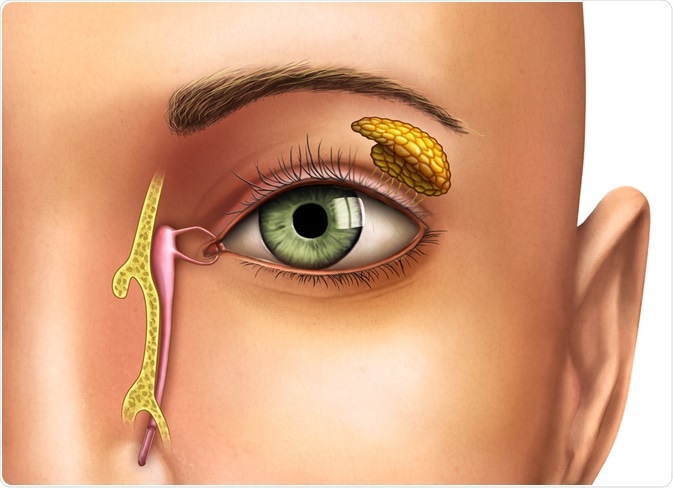A fistula can be defined as an abnormal passage or opening between two organs, but also between a specific organ and a body surface. Fistulas can be a result of several disease conditions or may be surgically created for therapeutic reasons in some instances. Various conditions that affect different organ systems can result in fistula formation.

Lacrimal fistulas are rare developmental conditions that affect the lacrimal ducts between the eyes and the nose. Image Credit: Andrea Danti / Shutterstock.com
Fistulas of the gastrointestinal tract
Diseases of the bowel such as Crohn’s disease can cause fistulas that may occur between the stomach and the intestines (entero-enteral fistula), between the intestines and the skin (entero-cutaneous fistula), and anorectal fistulas, for example. In fact, fistula formation is often considered a hallmark of chronic Crohn’s disease, as it is found in at least half of all patients with this condition.
A salivary fistula describes an abnormal connection between a salivary gland duct and an opening in the mouth through which saliva is discharged. Trauma is considered the most common cause of this type of fistula, albeit other causes (namely, operative complications, malignancy or infection) must be considered.
Gastro-jejunal fistulas can form between the stomach and the jejunum or the middle part of the small intestine as a result of a gastric ulcer. Furthermore, fistulas can also develop between the stomach and duodenum, which is a well-established complication of peptic ulcer disease known as “double pylorus.”
After gallbladder surgery, a biliary fistula may form between the biliary tract and the intestines or liver. It is commonly a result of a rushed gallbladder removal by an inexperienced surgeon, with the injury usually stemming from imprecise dissection and unskillful demonstration of the adjacent anatomical structures.
What causes fistulas in other parts of the body?
Head injuries may lead to a perilymph fistula or tear in the thin membranes of the middle and inner ear, creating an abnormal passage between the middle and inner ear. Injuries may also cause an arteriovenous fistula or fistula between an artery and a vein. A mastoid fistula forms over the side of the head behind the ear and can occur as a complication of otitis media.
A person with severe hidradenitis suppurativa, a chronic infection that affects the apocrine glands of the armpits and groin, is likely to develop fistulas. It occurs when channels (also known as sinus tracts) tunnel into other areas of the human body, such as the bladder or bowel.
A pulmonary arteriovenous fistula refers to a fistula that forms between an artery and a lung vein, usually as a result of abnormal blood vessel development in the lungs (for example, in patients with hereditary hemorrhagic telangiectasia). Tracheoesophageal fistulas can also form between the windpipe and the food pipe.
Radiation therapy applied to the genital area may lead to a fistula forming between the vagina and the bladder (vesicovaginal fistula). Obstructed and complicated labor may also give rise to a vesicovaginal or rectovaginal (i.e. between the rectum and vagina) fistula. In men, urethral fistula is sometimes observed as a rare complication of urethral and penile surgery.
Spotlight on Perianal Fistulas Research | Johns Hopkins Meyerhoff IBD Center
Congenital fistulas
If a child is born with a cleft palate, an abnormal communication between the oral and nasal cavities can be observed. After the initial surgical repair is pursued, residual abnormal oronasal communications – also known as oronasal fistulas – pose a frequent problem that entails subsequent surgical procedures.
Another significant example of a congenital fistula is rectovestibular fistula, which is the most frequently observed anorectal malformation in female patients.
Also, lacrimal fistulas are rare developmental conditions that affect the lacrimal ducts between the eyes and the nose. Congenital fistulas may also include fistula of the salivary gland, portal vein-hepatic artery fistula, as well as other fistulas of the rectum and anus.
References
Further Reading
Last Updated: Aug 18, 2022